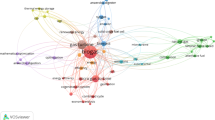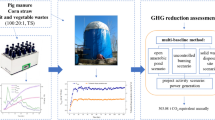Abstract
Potential environmental impacts of biogas electricity from agricultural residues (maize stover) with steam explosion (SE) pretreatment were compared to a typical Austrian biogas system (maize silage) using the method of life cycle assessment. Besides the biogas plant, the system includes substrate production, a combined heat-and-power (CHP) unit, digestate management, and transportation. The stover scenario (including construction and operation of the SE unit) results in lower total climate change impacts than those of the typical biogas system (239 g CO2-eq/kWh electricity vs. 287 g CO2-eq/kWh electricity; 100-year global warming potential (GWP)), and this holds also for the other impact categories (e.g., cumulative energy demand, acidification, eutrophication). While uncertainties in other areas could change the results, based on the uncertainty information considered, the overall results for the two scenarios were significantly different. Methane slip emissions from the CHP exhaust account for the largest GWP share in both scenarios. Other large GWP contributions are from substrate production and grid electricity for plant operations. The findings were robust against worst-case assumptions about the energy requirements of the SE pretreatment.





Similar content being viewed by others
References
Österreichischer Biomasseverband (2013) Basisdaten 2013 Bioenergie Österreich. Vienna
Wolf M-A, Pant R, Chomkhamsri K, Sala S, Pennington D (2012) Characterisation factors of the ILCD recommended life cycle impact assessment methods. Database and supporting information. First edition. Luxembourg. doi:10.2788/85727
Walla C (2006) Wirtschaftlichkeit von Biogasanlagen. Dissertation, University of Natural Resources and Life Sciences Vienna
Tragner F, Lins S, Hornbacher D, Kryvoruchko V, Konrad G, Bomatter A (2008) Biogas Branchenmonitor Endbericht 2008. Erhebung von Wirtschaftsdaten und Trends zu Biogas in Österreich, im Auftrag des BMVIT. Vienna
Bauer A, Frühauf S, Gronauer A (2014) Landwirtschaftliches Reststoff-Potenzial für Biogas – technische Umsetzungs- und Handlungserfordernisse. Paper presented at the 4th Central European Biomass Conference 2014, Graz
Hendriks ATWM, Zeeman G (2008) Pretreatments to enhance the digestibility of lignocellulosic biomass. Bioresour Technol 100(1):10–18. doi:10.1016/j.biortech.2008.05.027
Clark TA, Mackie KL (1987) Steam explosion of the softwood Pinus radiata with sulphur dioxide addition. I. Process optimization. J Wood Chem Technol 7(3):373–403. doi:10.1080/02773818708085275
Horn SJ, Nguyen QD, Westereng B, Nilsen PJ, Eijsink VGH (2011) Screening of steam explosion conditions for glucose production from non-impregnated wheat straw. Biomass Bioenergy 35(12):4879–4886. doi:10.1016/j.biombioe.2011.10.013
Menardo S, Bauer A, Theuretzbacher F, Piringer G, Nilsen PJ, Balsari P, Pavliska O, Amon T (2012) Biogas production from steam-exploded miscanthus and utilization of biogas energy and CO 2 in greenhouses. Bioenergy Res 1–11. doi:10.1007/s12155-012-9280-5
Sargalski W, Solheim OE, Fjordside C (2007) Treating organic waste with CAMBI THP. Paper presented at the 12th European Biosolids and Organic Resources Conference, Manchester
Schumacher B, Oechsner H, Senn T, Jungbluth T (2010) Life cycle assessment of the conversion of Zea mays and x triticosecale into biogas and bioethanol. Eng Life Sci 10(6):577–584. doi:10.1002/elsc.201000069
Nemecek T, Kägi T (2007) Life cycle inventories of agricultural production systems. ecoinvent report, vol 15. Agrosope Reckenholz-Tänikon Research Station ART, Zürich and Dübendorf
Laaber M (2011) Gütesiegel Biogas. Evaluierung der technischen, ökologischen und sozioökonomischen Rahmenbedingungen für eine Ökostromproduktion aus Biogas. Dissertation, University of Natural Resources and Life Sciences Vienna
Bachmaier J (2012) Treibhausgasemissionen und fossiler Energieverbrauch landwirtschaftlicher Biogasanlagen. Eine Bewertung auf Basis von Messdaten mit Evaluierung der Ergebnisunsicherheit mittels Monte-Carlo-Simulation. Dissertation, University of Natural Resources and Life Sciences Vienna
Ecoinvent data v 2.2. (2010) Swiss centre for life cycle inventories. www.ecoinvent.org. Accessed 04 March 2014
Fachagentur nachwachsende Rohstoffe (2009) Biogas-Messprogramm 2: 61 Biogasanlagen im Vergleich. Fachagentur Nachwachsende Rohstoffe, Gülzow
Fachagentur nachwachsende Rohstoffe (2010) Leitfaden Biogas - Von der Gewinnung zur Nutzung, Germany
Siegl S (2010) Öko-Strom aus Biomasse. Dissertation, University of Natural Resources and Life Sciences Vienna
Amon B, Kryvoruchko V, Amon T, Zechmeister-Boltenstern S (2006) Methane, nitrous oxide and ammonia emissions during storage and after application of dairy cattle slurry and influence of slurry treatment. Agric Ecosyst Environ 112(2–3):153–162. doi:10.1016/j.agee.2005.08.030
Wulf S, Maeting M, Clemens J (2002) Application technique and slurry co-fermentation effects on ammonia, nitrous oxide, and methane emissions after spreading. J Environ Qual 31(6):1795–1801. doi:10.2134/jeq2002.1795
Agrinz Technologies GmbH (2012) Corn straw. Austria
Chamber of Agriculture (2012) Marktbericht der Niederösterreichischen Landes-Landwirtschaftskammer. Markt Niederösterreich 41:2, Austria
Schindler M (2014) Getreidestroh verkaufen oder einarbeiten? Landwirtschaftskammer Niedersachsen, Germany. http://www.lwk-niedersachsen.de/index.cfm/portal/6/nav/360/article/21106.html Accsessed 20 April 2015
Statistik Austria (2014) Feldfruchtproduktion ab 1970. Vienna. http://www.statistik.at/web_de/statistiken/land_und_forstwirtschaft/agrarstruktur_flaechen_ertraege/feldfruechte/ Accessed 05 May 2014
Bavarian State Research Center for Agriculture (2012) Biogas in Bayern - Zahlen zum 31.12.2011, Germany
Gronauer A (2007) Biogashandbuch Bayern - Materialienband: Auszug 1.1 - 1.6. Bayerisches Landesamt für Umweltschutz, Augsburg
Bundesministerium für Land- und Forstwirtschaft Umwelt und Wasserwirtschaft (2008) Deckungsbeiträge und daten für die betriebsplanung. Bundesministerium für Land- und Forstwirtschaft, Austria, Umwelt und Wasserwirtschaft, Referat II 2b - Beratung, Wien
Hopfner-Sixt K (2005) Analyse von Leistungsfähigkeit, Wirtschaftlichkeit und Entwicklungsperspektiven landwirtschaftlicher Biogasanlagen. Dissertation, University of Natural Resources and Life Sciences Vienna
Döhler H, Eckel H, Fröba N, Grebe S, Hartmann S, Häußermann U, Klages S, Sauer N, Nakazi S (2009) Faustzahlen biogas. Kuratorium für Technik und Bauwesen in der Landwirtschaft e.V. (KTBL), Darmstadt
Pavliska O, Theuretzbacher F, Bauer A, Amon B, Amon T, Kaul H-P (2012) Efficient utilization of lignocellulosic crop residues for biogas production using an optimized process chain. Paper presented at the 20th European Biomass Conference and Exhibition, Milan
Panther K, Solheim OE, Fjordside C (2004) Hydrolysis and digestion of biodegradable municipal waste at Lillehammer, Norway. 2 years full scale experience, Norway
Achilles W (2005) Faustzahlen für die Landwirtschaft. Kuratorium für Technik und Bauwesen in der Landwirtschaft. KTBL-Schriftenvertrieb im Landwirtschaftsverlag, Münster
Goedkoop M, Heijungs R, Huijbregts M, De Schryver A, Struijs J, Zelm Rv (2013) ReCiPe 2008, a life cycle impact assessment method which comprises harmonised category indicators at the midpoint and the endpoint level. First edition Report I: Characterisation, Netherlands
Frischknecht R, Jungbluth N, Althaus H-J, Bauer C, Doka G, Dones R, Hirschier R, Hellweg S, Humbert S, Köllner T, Loerinci Y, Margni M, Nemecek T (2007) Implementation of life cycle impact assessment methods. Ecoinvent report No. 3, v2.0. Swiss Centre for Life Cycle Inventories, Dübendorf
Intergovernmental Panel on Climate Change (2013) Climate change 2013: the physical science basis. Contribution of working group I to the fifth assessment report of the intergovernmental panel on climate change. Cambridge University Press, Cambridge
Intergovernmental Panel on Climate Change (2007) Climate change 2007: the physical science basis. In: Solomon S, Qin D, Manning M, Chen Z, Marquis M, Averyt KB, Tignor M, Miller HL (eds) Contribution of working group I to the fourth assessment report of the intergovernmental panel on climate change. Cambridge University Press, Cambridge
Rosenbaum RK, Bachmann TM, Gold LS, Huijbregts MAJ, Jolliet O, Juraske R, Koehler A, Larsen HF, MacLeod M, Margni MD, McKone TE, Payet J, Schuhmacher M, van de Meent D, Hauschild MZ (2008) USEtox—the UNEP-SETAC toxicity model: recommended characterisation factors for human toxicity and freshwater ecotoxicity in life cycle impact assessment. Int J Life Cycle Assess 13:532–546. doi:10.1007/s11367-008-0038-4
IBM Corp. (2012) IBM SPSS Statistics for Windows, Version 21.0. New York
Prasuhn V (2006) Erfassung der PO4-Austräge für die Ökobilanzierung. Agroscope FAL Reckenholz, Switzerland
Acknowledgments
This study was carried out as part of the COMET (Competence Centers for Excellent Technologies) program at the alpS-Centre for Climate Change Adaptation. The program is an initiative of the Federal Ministry of Transport, Innovation and Technology and the Federal Ministry of Science, Research and Economy. Additional support for the program comes from the federal states of Tyrol and Vorarlberg. The program is administered by the Austrian Research Promotion Agency (FFG). The authors thank two anonymous reviewers for valuable comments and suggestions.
Author information
Authors and Affiliations
Corresponding author
Rights and permissions
About this article
Cite this article
Kral, I., Piringer, G., Saylor, M.K. et al. Environmental Effects of Steam Explosion Pretreatment on Biogas from Maize—Case Study of a 500-kW Austrian Biogas Facility. Bioenerg. Res. 9, 198–207 (2016). https://doi.org/10.1007/s12155-015-9676-0
Published:
Issue Date:
DOI: https://doi.org/10.1007/s12155-015-9676-0




